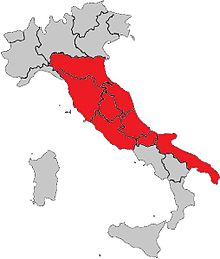Montepulciano is a red Italian wine grape variety that is most noted for being the primary grape behind the Denominazione di Origine Controllata e Garantita(DOCG) wine Montepulciano d'Abruzzo Colline Teramane (as well its larger DOC outside of Colline Teramane) and the Denominazione di origine controllata(DOC) wines of Rosso Conero and Rosso Piceno.
It should not be confused with the similarly named Tuscan wine Vino Nobile di Montepulciano, which is made from predominantly Sangiovese and is named for the village it is produced in, rather than for containing any Montepulciano grapes in the blend.
| Wine description |
Deeply colored wines, with moderate acidity and noticeable extract and alcohol levels, low tannins --smooth, drinkable wines that can improve for three or four years after vintage. |
| Food pairing |
pasta with a meat-based ragù, Eggplant Alla Parmigiana |
| Origin |
Tuscany, Italy |
| Notable regions |
Italy |
| Notable wines |
Emidio Pepe Montepulciano d’Abruzzo |
The grape is widely planted throughout central and southern Italy, most notably in Abruzzi, Latium, Marche, Molise, Umbria and Apulia, and is a permitted variety in DOC wines produced in 20 of Italy's 95 provinces. Montepulciano is rarely found in northern Italy because the grape has a tendency to ripen late and can be excessively "green" if harvested too early.
When fully ripened, Montepulciano can produce deeply colored wines, with moderate acidity and noticeable extract and alcohol levels.[1]
Origins and confusion with other Montepulciano wines
According to wine expert Jancis Robinson, Montepulciano likely originated in Tuscany and may be related to Sangiovese of which the two grapes are often confused for each other. Despite this possible origin, the Montepulciano grape still doesn't seem to have any tangible connection to the Montepulciano village and the Vino Nobile di Montepulciano beyond, what Robinsons describes as, "linguistics".[2][3] Furthermore, despite being widely planted throughout central Italy, the Montepulciano grape is not even grown in the vineyards around the village of Montepulciano.[4][5]
Wine regions
 |
|
The spread of the Montepulciano grape throughout Italy.
After Sangiovese, Montepulciano is Italy's second most widely dispersed indigenous grape variety. |
It is a recommend planting in 20 of Italy's 95 provinces and is a permitted or required grape in the red wines of DOCs in Apulia, Molise, Latium, Umbria, Marche, Emilia-Romagna, Abruzzi and Tuscany. Among the DOCs that are most noted for Montepulciano are Montepulciano d'Abruzzo in Abruzzi, Rosso Conero and Rosso Piceno in Marche. Though it is a secondary variety to Uva di Troia in the Castel Del Monte DOC, wine expert Jancis Robinson the character that Montepulciano contributes to the blend as perhaps
"its finest incarnation".[2]
Viticulture and wines
Montepulciano ripens late and has a tendency to favor producing large yields. The grapes can be plump with a low skin to juice ratio. However, the skin has a fair amount of pigmented tannins and color producing phenols that with maceration can produce either a deep ruby colored wine or a pink Cerasuolo wine.[2] Compared to most Italian varieties, Montepulciano has moderately low acidity and more mild (i.e. softer) than bitter edged tannins.[3]Wine expert Oz Clarke describes Montepulciano as producing a "round, plummy and weighty red with ripe tannins, good acidity and a low price tag."[7] Jancis Robinson evaluates Montepulciano as a "promising variety"that produces smooth, drinkable wines that can improve for three or four years after vintage.[2]
References
- J. Robinson Jancis Robinson's Guide to Wine Grapes p. 112 Oxford University Press 1996
- J. Robinson Vines, Grapes & Wines p. 212 Mitchell Beazley 1986
- Loren Sonkin "Montepulciano d'Abruzzo" Accessed: December 30th, 2010
- J. Robinson (ed) "The Oxford Companion to Wine" Third Edition p. 450 Oxford University Press 2006
- Anthony Giglio "Montepulciano: the real deal" La Cucina Italiana Magazine. Accessed: December 31st, 2010
- P. Saunders Wine Label Language pp. 119-215 Firefly Books 2004
- Oz Clarke Encyclopedia of Grapes p. 139 Harcourt Books 2001
- Vitis International Variety Catalogue "Montepulciano entry" Accessed: December 28th, 2010
Some or all of this text has been obtained from Wikipedia, the free encyclopedia. All text is available under the terms of the
GNU Free Documentation License. Wikipedia is powered by MediaWiki, an open source wiki engine.
